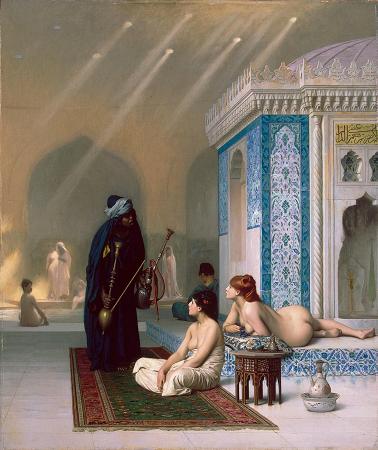Harem. Harem, also known as zenana in the Indian subcontinent, properly refers to domestic spaces that are reserved for the women of the house in a Muslim family. This private space has been traditionally understood as serving the purposes of maintaining the modesty, privilege, and protection of women. A harem may house a man's wife, or wives and concubines, as in royal harems of the past, their pre-pubescent male children, unmarried daughters, female domestic workers, and other unmarried female relatives. In former times some harems were guarded by eunuchs who were allowed inside. The structure of the harem and the extent of monogamy or polygamy has varied depending on the family's personalities, socio-economic status, and local customs. Similar institutions have been common in other Mediterranean and Middle Eastern civilizations, especially among royal and upper-class families, and the term is sometimes used in other contexts. Although the institution has experienced a sharp decline in the modern era due to a rise in education and economic opportunities for women, as well as Western influences, seclusion of women is still practiced in some parts of the world, such as rural Afghanistan and conservative states of the Gulf region. In the West, Orientalist imaginary conceptions of the harem as a hidden world of sexual subjugation where numerous women lounged in suggestive poses have influenced many paintings, stage productions, films and literary works. Some earlier European Renaissance paintings dating to the 16th century portray the women of the Ottoman harem as individuals of status and political significance. In many periods of Islamic history, women in the harem exercised various degrees of political power, such as the Sultanate of Women in the Ottoman Empire. The word has been recorded in the English language since early 17th century. In English the term harem can mean also the wives of a polygamous man. In Turkish of the Ottoman era, the harem, i.e. The practice of female seclusion is not exclusive to Islam, but the English word harem usually denotes the domestic space reserved for women in Muslim households. Some scholars have used the term to refer to polygynous royal households throughout history. Leila Ahmed describes the ideal of seclusion as a a man's right to keep his women concealed, invisible to other men. Ahmed identifies the practice of seclusion as a social ideal and one of the major factors that shaped the lives of women in the Mediterranean Middle East. For example, contemporary sources from the Byzantine Empire describe the social mores that governed women's lives. Women were not supposed to be seen in public. They were guarded by eunuchs and could only leave the home veiled and suitably chaperoned. Some of these customs were borrowed from the Persians, but Greek society also influenced the development of patriarchal tradition. The ideal of seclusion was not fully realized as social reality. This was in part because working class women often held jobs that required interaction with men. In the Byzantine empire, the very ideal of gender segregation created economic opportunities for women as midwives, doctors, bath attendants and artisans, since it was considered inappropriate for men to attend to women's needs. At times women lent and invested money and engaged in other commercial activities. Historical records shows that the women of 14th-century Mamluk Cairo freely visited public events alongside men, despite objections of religious scholars. The practice of gender segregation in Islam was influenced by an interplay of religion, customs and politics. Female seclusion has historically signaled social and economic prestige. Eventually, the norms of female seclusion spread beyond the elites, but the practice remained characteristic of upper and middle classes, for whom the financial ability to allow one's wife to remain at home was a mark of high status. In some regions, such as the Arabian peninsula, seclusion of women was practiced by poor families at the cost of great hardship, but it was generally economically unrealistic for the lower classes. Where historical evidence is available, it indicates that the harem was much more likely to be monogamous.
more...



